four wheel drive AUDI S4 2015 Owners Manual
[x] Cancel search | Manufacturer: AUDI, Model Year: 2015, Model line: S4, Model: AUDI S4 2015Pages: 304, PDF Size: 74.86 MB
Page 91 of 304
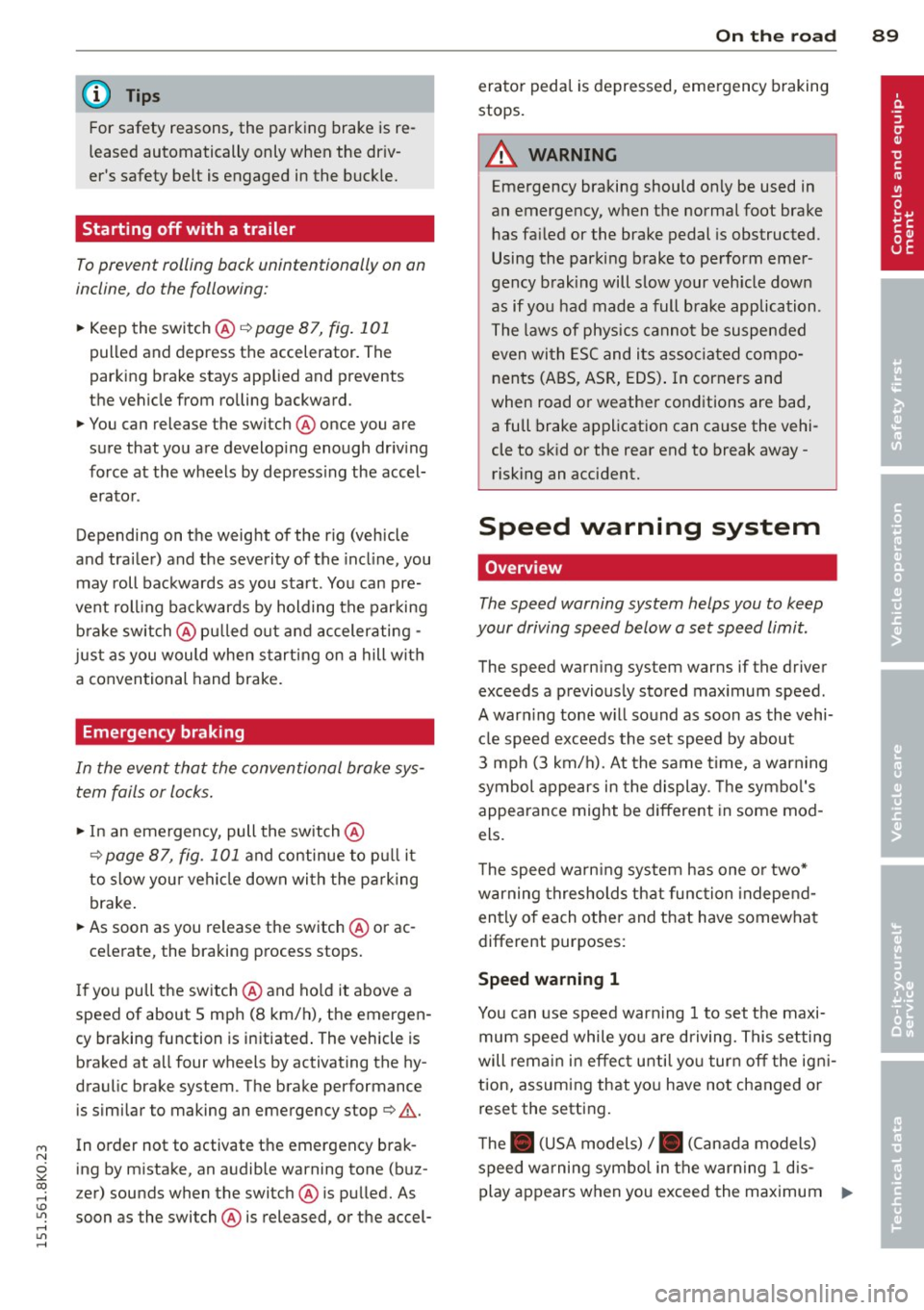
"' N
0 ::.,: co ,...., \!) ..,.,
,...., ..,., ,....,
@ Tips
For safety reasons, the par king brake is reĀ
leased au tomatically only when the dr ivĀ
er 's safety belt is engage d in the buckle.
Starting off with a trailer
To prevent rolling back unintentionally on an
incline , do the following:
~ Keep the switch @Ā¢ page 87, fig . 101
pulled and depress the accelerator. The
park ing brake stays app lied and prevents
the vehicle from rolling backward.
~ You can release the switch @once you are
sure that you are develop ing enough dr iv ing
force at the wheels by depress ing the accelĀ
erator .
Depending on the weight of the r ig (vehicle
and trailer) and the severity of the incl ine, you
may roll backwards as you start . You can preĀ
ve nt rolling backwards by holding the parking
b rake sw itch @pulled out and accelerating -
jus t as you would whe n starting on a hill with
a conventional hand brake.
Emergency braking
In the event that the conventional brake sys Ā
tem fails or locks.
~ I n an eme rgency, pull the sw itch @
Ā¢page 87, fig. 101 and continue to p ull it
to s low your vehi cle down wi th the pa rk ing
brake .
~ As soon as you release the switch @ or ac-
ce lerate, the braking process stops.
I f you pull the switch @and ho ld it above a
speed of about 5 mph (8 km/h), the emergen Ā
cy braking function is initiated . The vehicle is
braked at a ll four wheels by activating the hyĀ
draulic brake system. T he brake performance
is similar to making an emergency stop Ā¢
&. .
In order not to activate the emergency brak Ā
ing by m istake, an a udible warning tone (buzĀ
zer) sounds when the switch @is pulled. As
soon as the switch @ is released, or the accel-
On th e ro ad 89
erator peda l is depressed, eme rgency braking
stops.
A WARNING
Emergency braking should only be used in
an emergency, when the norma l foot brake
has fa iled or the brake pedal is obstructed.
Using the parking brake to perform emerĀ
gency b rak ing will slow your vehicle down
as if you had made a full bra ke application .
T he laws of physics cannot be suspended
even with ESC and its asso ciated compoĀ
nents (ABS, ASR , EDS) . In corners and
when road or weathe r conditions are bad,
a full brake application can ca use the vehiĀ
cle to sk id or the rear end to break away -
risking an accident.
Speed warning system
Overv iew
The speed warning system helps you to keep
your driving speed below a set speed limit.
The speed warn ing system warns if the driver
exceeds a previous ly stored max imum speed.
A war ning tone w ill so und as soon as the vehiĀ
cle speed exceeds the set speed by about 3 mph (3 km/h). At the same time, a warn ing
symbol appears in the display. The symbo l's
appearance might be different in some mod Ā
els.
T he speed wa rn ing system has one or two*
warning thresholds that func tion independ Ā
en tly of each othe r and that have somewhat
different purposes:
Speed warning 1
You can use speed warn ing 1 to set the maxiĀ
mum speed while you are d riving. This se tting
will re ma in in effec t unti l yo u t urn
off the ig niĀ
tion, assuming that yo u have no t changed or
reset the setting.
T he . (USA models)/ . (Canada models)
speed wa rning sym bol in the warn ing 1 dis-
play appears w hen you exceed the maximum ..,.
Page 188 of 304
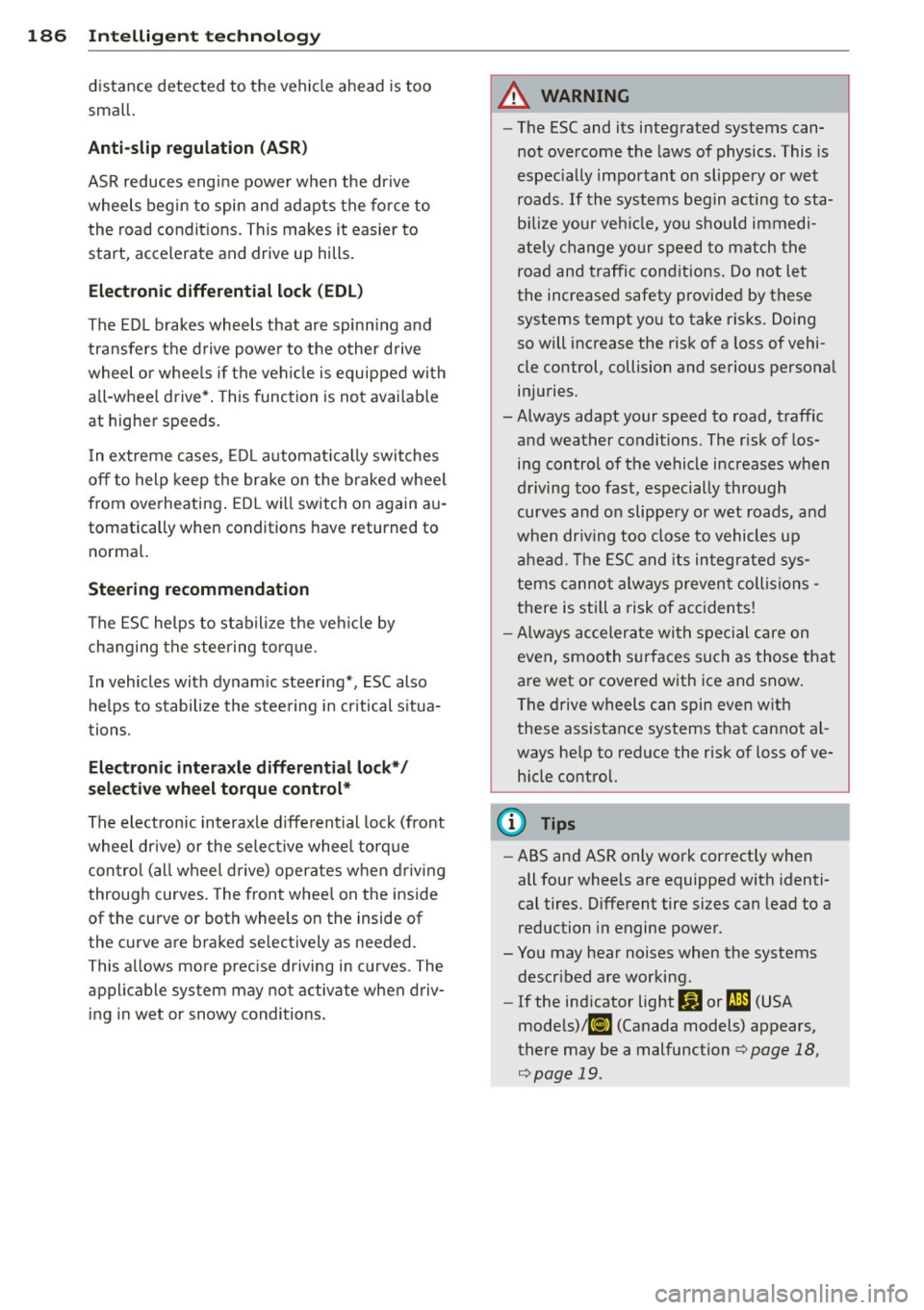
186 Intelligent technology
distance detected to the vehicle ahead is too
smal l.
Anti-slip regulation (ASR )
ASR reduces eng ine power when the drive
wheels begin to spin and adapts the fo rce to
the road condit ions. This makes it eas ier to
start, accelerate and drive up hills .
Electronic differential lock (EDL)
The EDL brakes wheels that are spinn ing and
transfers the d rive powe r to the other drive
wheel or whee ls if the vehicle is equipped with
a ll-wheel drive* . This function is not avai lab le
at higher speeds.
I n extreme cases , EDL automat ica lly switches
off to help keep the brake on the braked whee l
from ove rheating . EDL wi ll switch on again auĀ
tomatically when conditions have returned to
normal.
Steering recommendation
The ESC helps to stabilize the ve hicle by
changing the steering torque.
In vehicles with dynam ic steeri ng*, ESC also
he lps to stabilize the stee ring in critical s ituaĀ
tions.
Electronic interaxle differential lock* /
selective wheel torque control*
The electronic interaxle d ifferential lock (front
wheel drive) or the select ive wheel torque
con trol ( all wheel d rive) oper ates when driving
through curves . The front whee l on the inside
of the cu rve or both whee ls on the inside of
the curve are b raked se lectively as needed.
This a llows more prec ise driving in c urves. The
applicable system may not activate when drivĀ ing i n wet or snowy conditions.
A WARNING
- The ESC and its integrated systems canĀ
not overcome the laws of physics. This is
especially important on slippery o r wet
roads . If the systems begin acting to staĀ·
b iliz e your veh icle, you s hou ld immed iĀ
a tely c ha n ge your speed to match the
road and traffic cond itions. Do not let
the increased safety provided by these
systems tempt you to take risks. Do ing
so will increase the risk of a loss of vehiĀ
cle control, collision and serious personal
inj uries.
-Always adapt your speed to road, traffic and weather conditions. The risk of losĀ
ing control of the vehicle increases when
d riving too fast, espec ially through
curves and on slippe ry or wet roads, and
when dr iv ing too close to vehicles up
ahead. The ESC a nd its integrated sysĀ
tems canno t always p reven t collisions -
there is still a risk of acc idents!
- Always accelera te wi th spe cial care on
even, smooth s urfaces such as those that
are wet or covered with ice and snow.
The drive wheels can spin even with these assistance systems that cannot alĀ
ways he lp to red uce the risk of loss of veĀ
h icle control.
(D Tips
- ABS and ASR only work cor rectly when
all four wheels are equipped with identiĀ
cal tires. D ifferent tire sizes can lead to a
reduction in engine power .
- Yo u may hear noises when the systems
descr ibed are working.
- If the ind icator light
DJ or ml (USA
mode ls)l iiJ (Canada models) appears,
there may be a malfunction<=>
page 18,
<=>page 19 .
Page 192 of 304
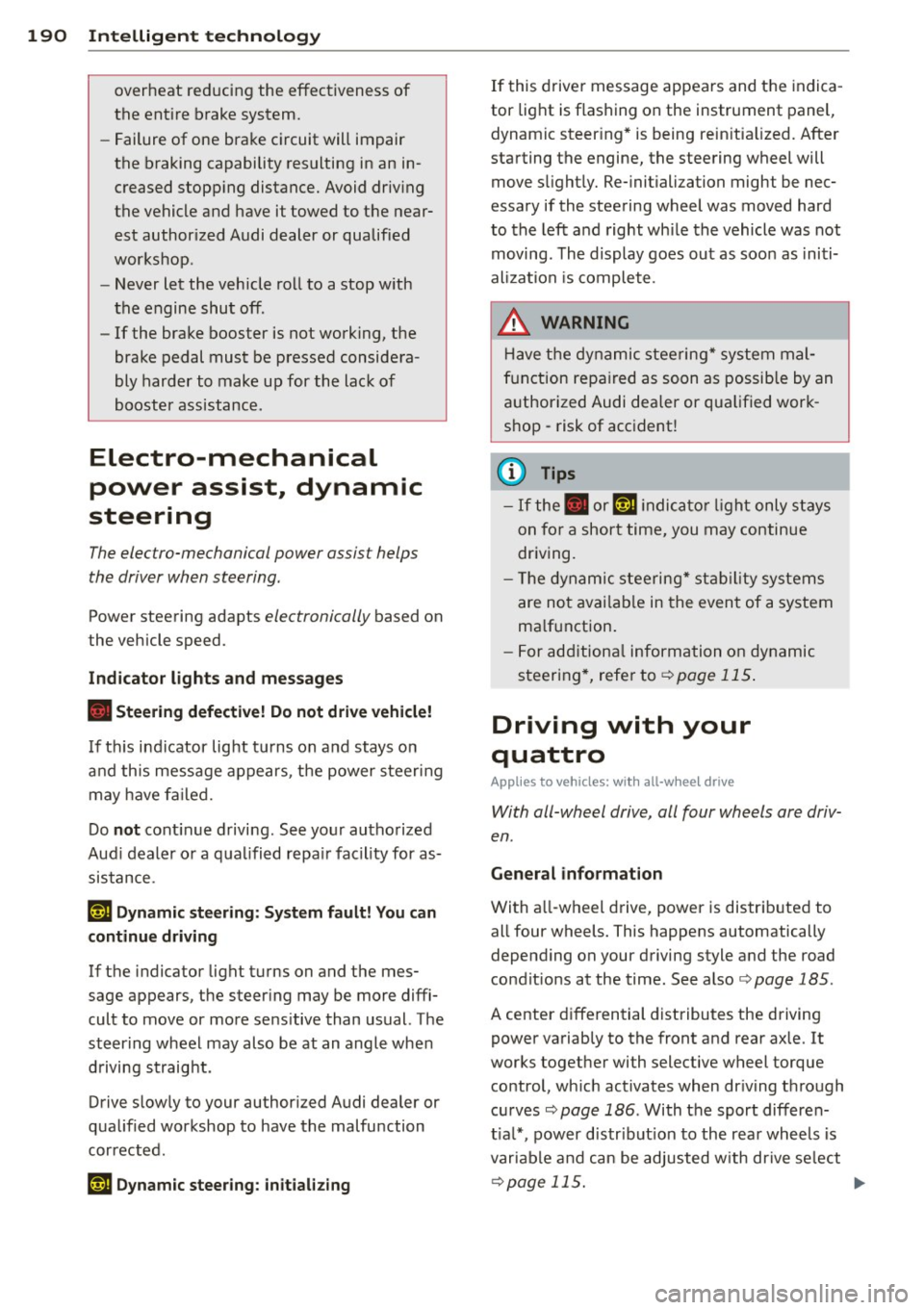
190 Intelligent technology
overheat re ducin g the effectiveness of
the ent ire brake system.
- Failure of one brake circuit will impair
the braking capability resulting in an inĀ
creased stopp ing distance. Avoid driv ing
the vehicle and have it towed to the nearĀ est author ized Audi dealer or qualified
workshop .
- Never let the vehicle ro ll to a stop w ith
the engine shut off.
- If the brake booster is not working, the
brake pedal must be pressed conside raĀ
bly harder to make up for the lac k of
booster assistance.
Electro-mechanical
power assist, dynamic
steering
The electro-mechanical power assist helps
the driver when steering.
Power stee ring adapts electronically based on
the vehicle speed.
Indicator lights and messages
ā¢ Steering defective! Do not drive vehicle!
If this ind icator lig ht tu rns on and stays on
an d th is message appears, t he power steer ing
may have f ailed.
D o
not cont in ue d riving. See yo ur autho rized
Aud i deale r or a q ua lifi ed r epa ir facility for asĀ
sistance.
'1:I Dynamic steering : System fault! You can
cont inue driv ing
If the indicator light t urns on and the mesĀ
sage appears, the steer ing may be more diffiĀ
cul t to move or more se nsitive than usual. The
steer ing wheel may also be at an angle whe n
d riving straight .
Drive s low ly to your author ized Audi dealer or
q ua lified workshop to have the malfunction
cor rected .
'y.ij Dynamic steering: initializing
If this driver message appears and the indica Ā
tor light is f lashing on the instrument panel,
dynam ic steer ing * is being re in it ia lized. After
starting the engine, the steering wheel will move s light ly. Re- initialization might be necĀ
essary if the steering wheel was moved hard
to the left and right wh ile the vehicle was not
moving . Th e display goes out as soon as ini tiĀ
ali za tion is complete.
_& WARNING
Ha ve the dy namic stee ring * system m alĀ
f u nction repa ired as soon as possib le by an
a uthorized Audi dea ler or qua lified work Ā
shop -risk of acc ident !
@ Tips
-If the . or '1:I indic ator li ght only s tays
on fo r a shor t time, you m ay continue
dr iving.
- T he dynamic s teering * stabi lit y syste ms
are no t av ail ab le in the even t of a system
ma lf u nction.
- F or ad di tion al information on dynamic
steering *, refe r to
Ā¢page 115 .
-
Driving with your
quattro
App lies to vehicles: wi th all-w hee l drive
With a/I-wheel drive, all four wheels are drivĀ
en .
General information
With a ll-wheel d rive, power is distr ib uted to
all four wheels. This happens automatically
depending on your driving style and the road
co ndit ions at the time . See also
Ā¢ page 185.
A center d ifferential distributes the driving
power variably to the front and rear axle. It
wor ks together with selective w heel torque
co ntrol, wh ich activates when dr iving t hrough
c ur ves
c::;,page 186. With the sport differe nĀ
t ia l* , pow er d istr ibut ion to the rea r wheels is
variable a nd can be adjusted w ith drive se lect
c::;, page 115. .,..
Page 193 of 304
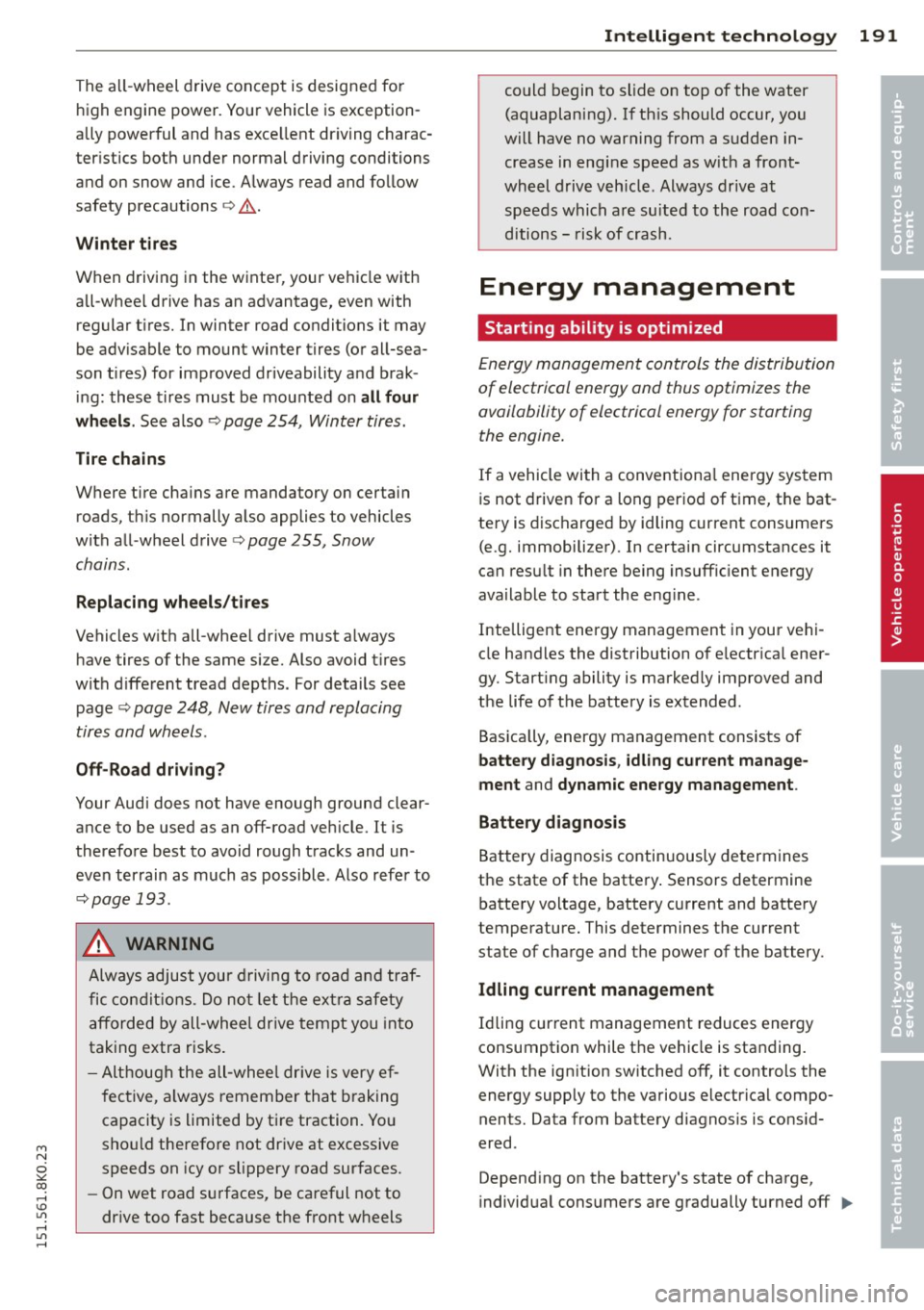
"" N
0 ::.,: co ,...., \!) 1.1'1 ,...., 1.1'1 ,....,
The all-wheel drive concept is designed fo r
high engine power. Your vehicle is exception Ā
ally powerful and has exce llent dr iving characĀ
ter istics both under normal driving conditions
and on snow and ice . Always read and follow
safety precautions
c> & .
Winte r tir es
When driving in the winter, your ve hicle with
all-wheel drive has an advantage, even with
regular t ires. In winter road conditions it may
be adv isable to mount winter tires (or all-seaĀ
son t ires) for imp roved driveability and brakĀ
ing: these tires must be mounted on
a ll four
w heel s.
See also c> page 254, Winter tires.
Tire chain s
Where tire cha ins are mandatory on certain
roads, th is normally also applies to vehicles
with all-wheel drive
c> page 255, Snow
chains.
R eplacing wheel s/tire s
Vehicles with all-wheel drive must a lways
have tires of the same size. Also avoid t ires
with d ifferent tread depths . For details see
page ~
page 248, New tires and replacing
tires and wheels.
Off-Ro ad dri ving ?
Your Audi does not have enough ground clearĀ
ance to be used as an off-road veh icle. It is
therefore best to avoid rough tracks and unĀ
even terrain as much as possible . Also refer to
c> page 193.
A WARNING
Always adjust your driving to road and trafĀ
fic condit ions . Do not let the ext ra safety
afforded by all-wheel drive tempt you into
taking extra risks .
- Although the all-whee l dr ive is very efĀ
fective, a lways remember that b raking
capacity is limited by tire traction. Yo u
sho uld therefore not drive at excessive
speeds on icy or slippery road surfaces.
- On wet road surfaces, be careful not to
drive too fast because the front wheels
Int ellig ent technolog y 191
could begin to slide on top of the water
(aquaplaning). If th is should occur, you
will have no warning from a sudden inĀ crease in engine speed as w ith a frontĀ
wheel drive veh icle . Always drive at
speeds which are su ited to the road conĀ
ditions - risk of crash.
Energy management
Starting ability is optimized
Energy management controls the distribution
of electrical energy and thus optimizes the
availability of electrical energy for starting the engine.
If a vehicle with a conventiona l energy system
is not driven for a long period of time, the batĀ
tery is discharged by idling current consumers (e .g. immobilizer). In certain circumstances it
can resu lt in there being insuffic ient energy
available to start the eng ine .
Intelligent energy management in your vehiĀ
cle handles the distribution of e lectr ica l enerĀ
gy. Start ing ability is markedly improved and
the life of the battery is extended .
Basically, energy management consists of
battery diagnosis , idling current manageĀ
ment
and dynamic ene rgy management .
Batte ry diagnos is
Battery diagnosis continuously determines
the state of the battery . Sensors determine
battery voltage, battery current and battery
temperature. This determines the current
state of charge and the power of the battery.
Idling current management
Idling current management reduces energy
consumption while the vehicle is standing.
With the ign ition switched off, it controls the
energy supply to the various electrical compoĀ
nents. Data from battery diagnos is is cons idĀ
ered .
Depend ing on the battery's state of charge,
individual consumers are gradually turned
off .,_ ā¢
ā¢
Page 235 of 304
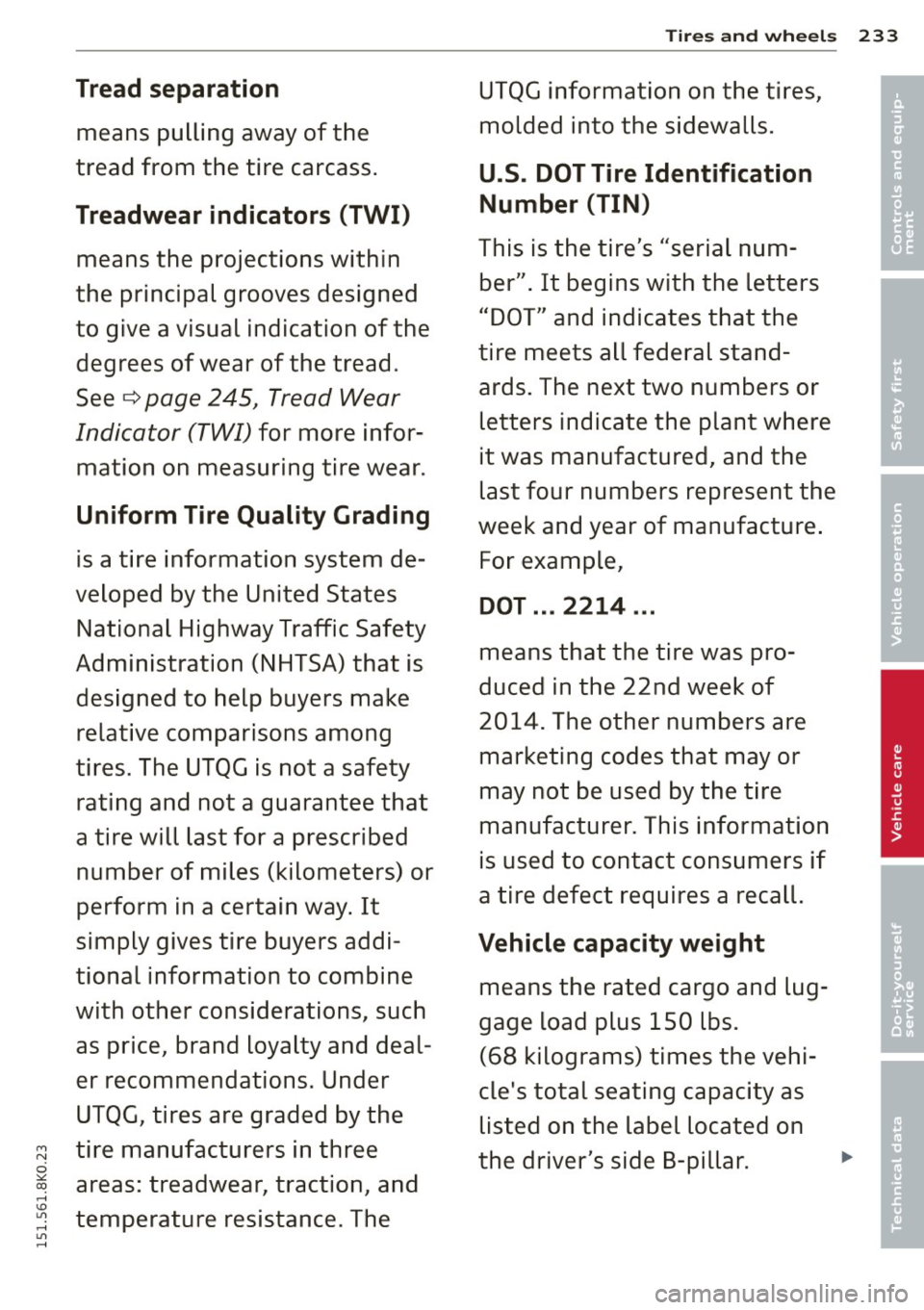
Tires and wheels 233
Tread separation UTQG information on the tires, ā¢
means pulling away of the molded into the sidewalls. ā¢ '
tread from the tire carcass. U.S. DOT Tire Identification
Treadwear indicators (TWI) Number (TIN)
means the projections within
This is the tire
's "serial num-
the principal grooves designed ber". It begins with the letters
to give a visual indication of the "DOT" and indicates that the
degrees of wear of the tread. tire meets all federal stand-
See
Ā¢ page 245, Tread Wear ards. The next two numbers or
Indicator (TWI) for more infor- letters indicate the plant where
mation on measuring tire wear. it was manufactured, and the
Uniform Tire Quality Grading
last four numbers represent the
week and year of manufacture.
is a tire information system de- For example,
veloped by the United States
DOT ... 2214 ...
National Highway Traffic Safety
Administration (NHTSA) that is means that the tire was pro-
designed to help buyers make duced in the 22nd week of
relative comparisons among 2014. The other numbers are
tires. The UTQG is not a safety marketing codes that may or
rating and not a guarantee that may not be used by the tire
a tire will last for a prescribed manufacturer. This information
number of miles (kilometers) or is used to contact consumers if
perform in a certain way. It a tire defect requires a recall.
simply gives tire buyers addi-
Vehicle capacity weight
tional information to combine means the rated cargo and lug-
with other considerations, such gage load plus 1
SO lbs.
as price, brand loyalty and deal- (68 kilograms) times the vehi-
er recommendations. Under cle's total seating capacity as
UTQG, tires are graded by the listed on the label located on
'"" tire manufacturers in three N
0 the driver's side 8-pillar. ...
::.,:
areas: treadwear, traction, and co ,...., \!) 1.1'1 temperature resistance. The ,...., 1.1'1 ,....,
Page 248 of 304
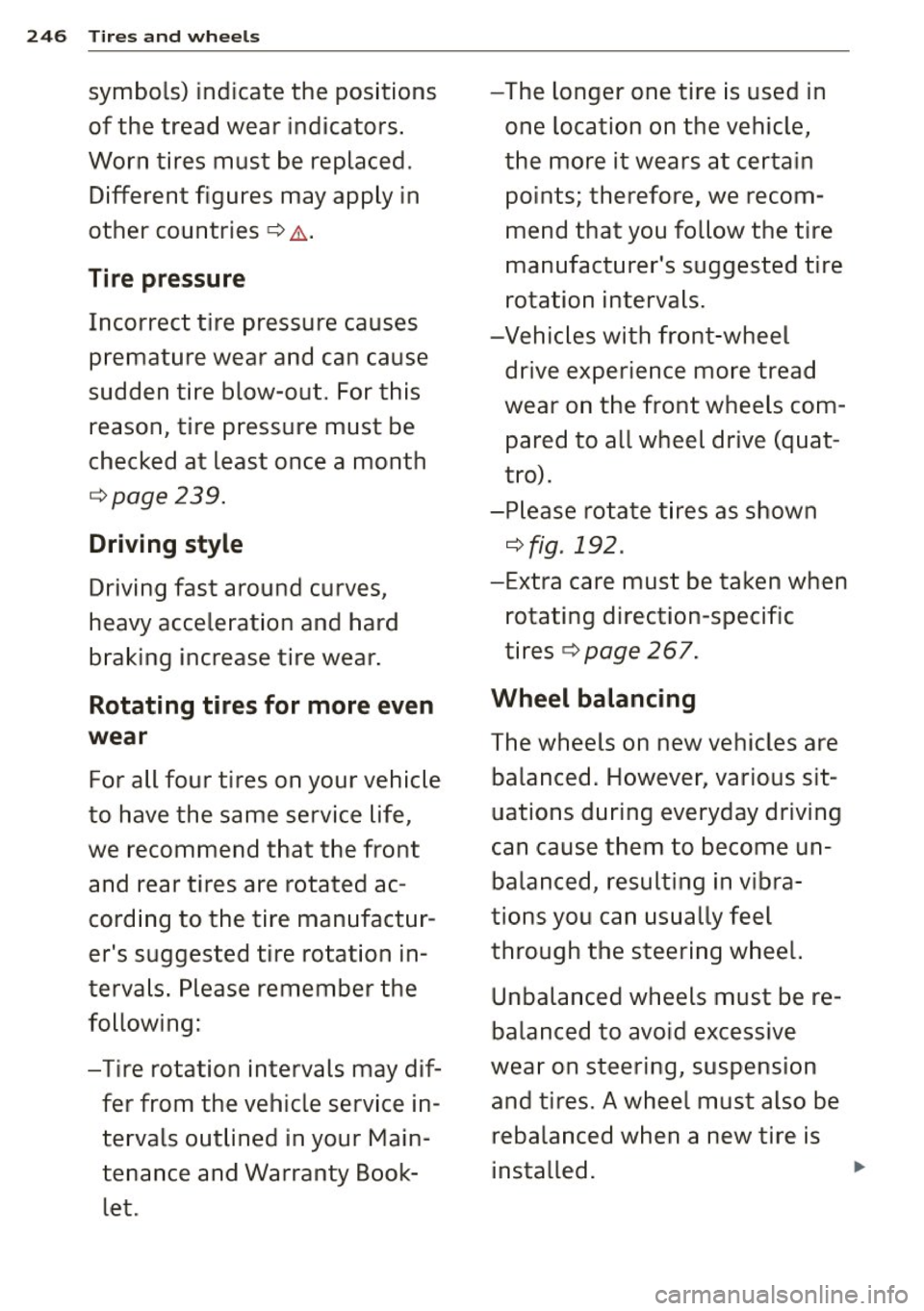
246 Tires and whee ls
symbols) indicate the positions
of the tread wear indicators .
Worn tires must be replaced. Different figures may apply in
other countries
s> .1:. .
Tire pressure
Incorrect tire pressure causes
premature wear and can cause
sudden tire blow-out. For this
reason, tire pressure must be
checked at least once a month
r::::>page239 .
Driving style
Driving fast around curves,
heavy acceleration and hard
b raking increase tire wear .
Rotating tires for more even
wear
For all four tires on your vehic le
to have the same service life,
we recommend that the front and rear tires are rota ted acĀ
cord ing to the tire man ufactur Ā
er's s uggested tire rotat ion inĀ
tervals. Please remember the
following:
-Tire rotation intervals may difĀ fer from the vehicle service in Ā
tervals outlined in your MainĀ
tenance and Warranty BookĀ let . -
The longer one tire is used in
o ne location on the ve hicle,
the more it wears at certain points; therefore, we recomĀ
mend tha t you follow the tire
manufact ure r's suggested tire
rotat ion interva ls .
- Vehicles with front -wheel
drive expe rience more tread
wear on the front whee ls comĀ
p ared to all wheel drive (q uatĀ
tro).
-Please rota te t ires as shown
r::::> fig . 192 .
-Extra care must be taken when
rotat ing direction-speci fic
tires c:> page 26 7.
Wheel balancing
The wheels on new vehicles are
balanced . Howeve r, various sit Ā
uations d uring everyday drivi ng
can cause them to become unĀ
balanced , resulting in vibra Ā
tions you can usu ally feel
through the s teering wheel.
Unbalanced wheels must be reĀ
ba lanced to avoid excessive
wea r on steering, suspension
and tires. A wheel must also be
rebalanced when a new tire is
insta lled .
Page 254 of 304
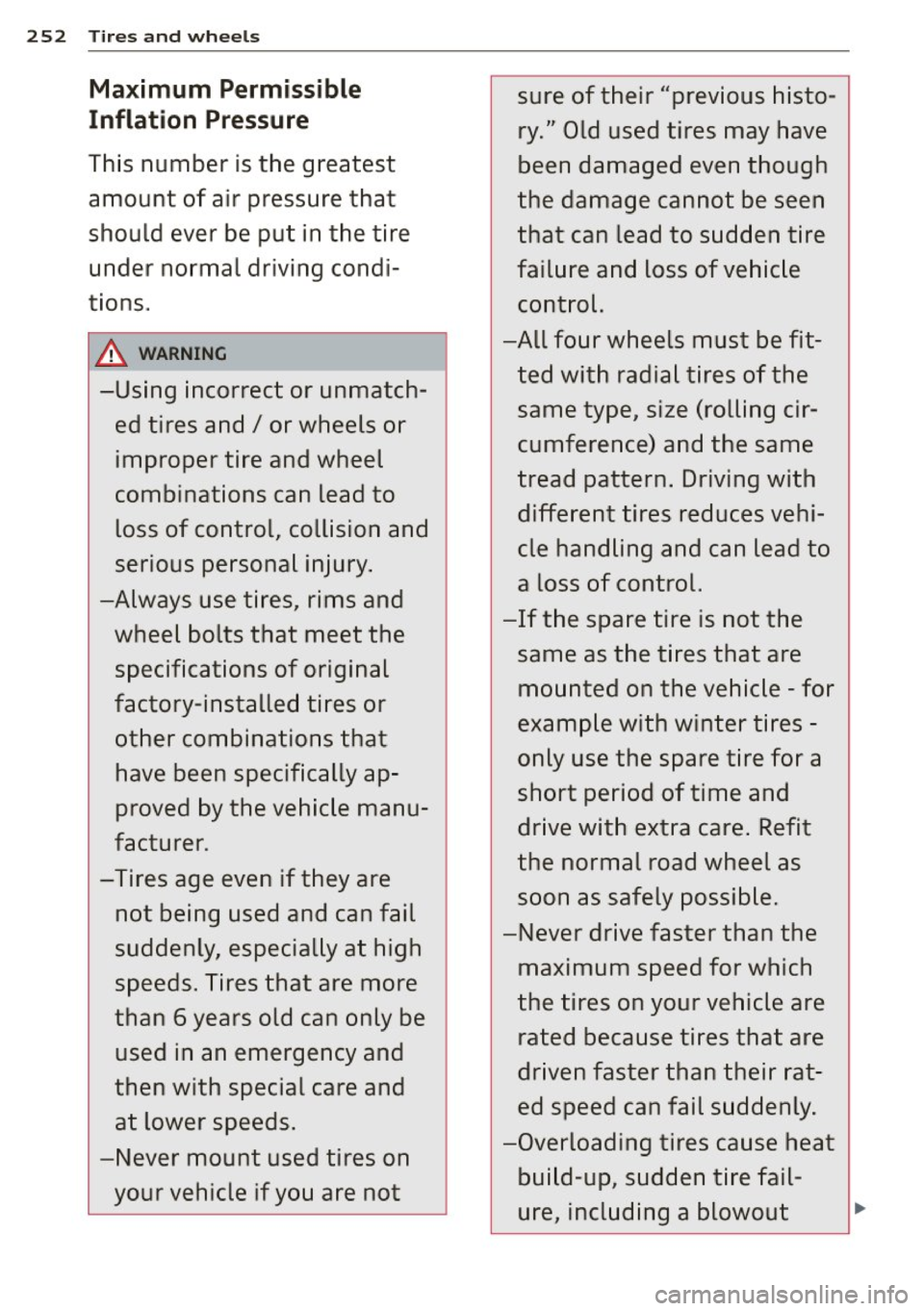
252 Tires and wheels
Maximum Permissible
Inflation Pressure
This number is the greatest
amount of air pressure that
should ever be put in the tire
under normal driving condiĀ
tions.
.&_ WARNING
-Using incorrect or unmatchĀ ed tires and/ or wheels or improper tire and wheel
combinations can lead to loss of control, collision and
serious personal injury.
-Always use tires, rims and wheel bolts that meet the
specifications of original
factory-installed tires or
other combinations that have been specifically apĀ
proved by the vehicle manuĀ
facturer.
-Tires age even if they are
not being used and can fail
suddenly, especially at high
speeds. Tires that are more
than 6 years old can only be used in an emergency and
then with special care and
at lower speeds.
-Never mount used tires on your vehicle if you are not sure of their "previous
histoĀ
ry." Old used tires may have
been damaged even though
the damage cannot be seen
that can lead to sudden tire
failure and loss of vehicle
control.
-All four wheels must be fitĀ ted with radial tires of the
same type, size (rolling cirĀ
cumference) and the same
tread pattern. Driving with different tires reduces vehiĀ
cle handling and can lead to
a loss of control.
-If the spare tire is not the
same as the tires that are
mounted on the vehicle -for
example with winter tires -
only use the spare tire for a
short period of time and
drive with extra care. Refit
the normal road wheel as soon as safely possible.
-Never drive faster than the maximum speed for which
the tires on your vehicle are
rated because tires that are
driven faster than their ratĀ
ed speed can fail suddenly.
-Overloading tires cause heat build-up, sudden tire fail Ā
ure, including a blowout
..
Page 255 of 304
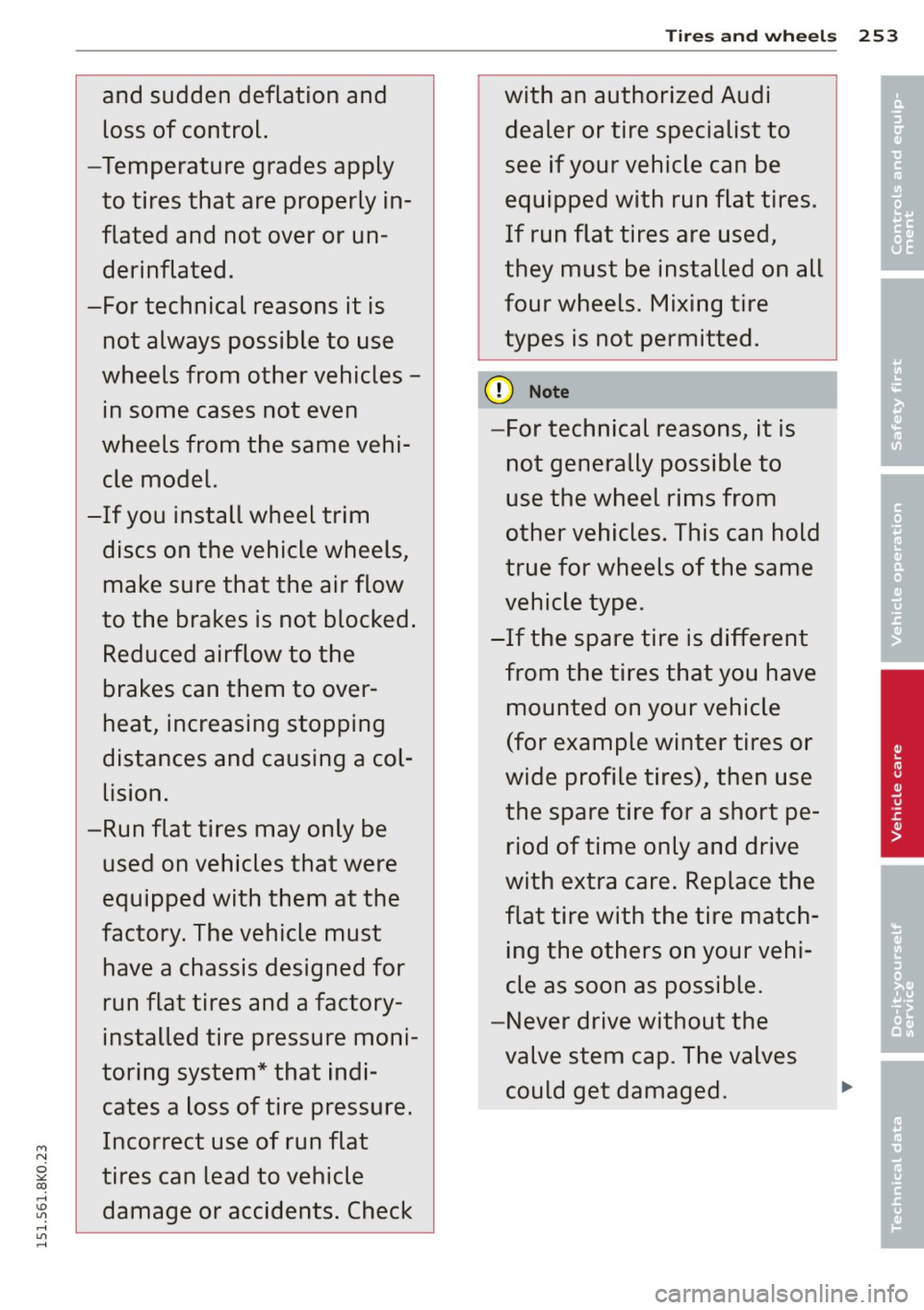
and sudden deflation and loss of control.
-Temperature grades apply to tires that are properly inĀ
flated and not over or un Ā
derinflated.
-For technical reasons it is not always possible to use
wheels from other vehicles_ 1n some cases not even
wheels from the same vehiĀ
cle model.
-If you install wheel trim discs on the vehicle wheels
I
make sure that the air flow
to the brakes is not blocked.
Reduced airflow to the
brakes can them to overĀ
heat, increasing stopping
distances and causing a colĀ lision.
-Run flat tires may only be used on vehicles that were
equipped with them at the
factory. The vehicle must have a chassis designed for
run flat tires and a factoryĀ
installed tire pressure moniĀ
toring system* that indiĀ cates a loss of tire pressure.
Incorrect use of run flat
tires can lead to vehicle damage or accidents. Check
Tires and wheels 253
with an authorized Audi dealer or tire specialist to
see if your vehicle can be
equipped with run flat tires.
If run flat tires are used
I
they must be installed on all
four wheels. Mixing tire types is not permitted.
(D Note
-For technical reasons, it is not generally possible to
use the wheel rims from
other vehicles. This can hold
true for wheels of the same
vehicle type.
-If the spare tire is different from the tires that you have mounted on your vehicle
(for example winter tires or
wide profile tires), then use
the spare tire for a short peĀ riod of time only and drive
with extra care. Replace the
flat tire with the tire matchĀ ing the others on your vehiĀ
cle as soon as possible.
-Never drive without the valve stem cap. The valves could get damaged.
I),
ā¢
ā¢
'
Page 257 of 304
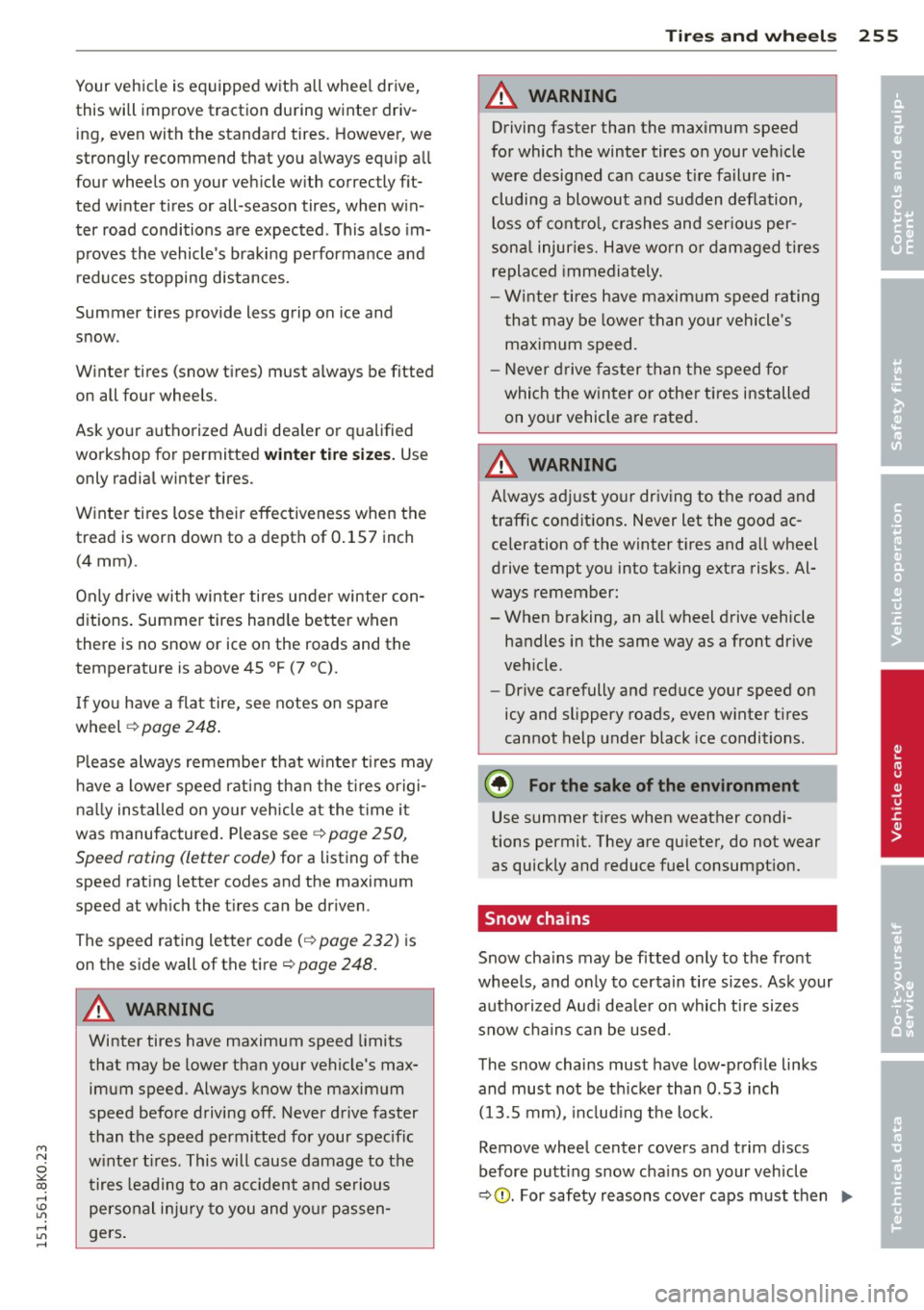
"" N
0 ::.,: co ...... \!) 1.1'1
...... 1.1'1 ......
Your vehicle is equipped with all whee l drive,
this will improve traction during winter drivĀ ing, even with the standard tires. However, we
strongly recommend that you a lways equ ip a ll
four wheels on your veh icle w ith correctly fitĀ
ted wi nte r tires or all -season tires, when w in Ā
ter road conditions are expected. This also imĀ
p roves the vehicle 's braking performance and
reduces stopping distances.
Summer tires provide less grip on ice and
snow .
W inter tire s (snow t ires) must always be fitted
on all four wheels.
Ask your authorized Audi dea ler o r qualified
workshop for permitted
w inter t ire sizes. Use
only radia l winter tires .
Winte r ti res lose thei r effectiveness when the
tread is worn down to a depth of
0 .15 7 inch
(4 mm) .
On ly drive with winter tires under winter conĀ
d itions. Summer tires hand le better when
there is no snow or ice on the roads and the
temperature is above 45
Ā°F (7 Ā°().
If yo u have a flat tire, see notes on spare
wheel Ā¢ page 248 .
Pl ease always remembe r th at w inte r ti res may
have a lower speed rating tha n the t ires origiĀ
n all y ins talled on your veh icle at the t ime i t
was manufactured . Please see Ā¢ page 250,
Speed roting (letter code) for a Listing of the
speed rat ing letter codes and the maximum
speed at wh ich the t ires can be driven .
The speed rating letter code( Ā¢ page 232) is
on the side wall of the tire Ā¢ page 248.
A WARNING
Winter tires have maximum speed limits
that may be lower than your vehicle's maxĀ
imum speed. Always know the maximum
speed befo re driving off . Never drive faster
than the speed permitted for your specific
w inte r tir es . This will cause damage to the
ti res leading to an ac cident and se rious
pe rsonal i njury to you and yo ur p assenĀ
gers .
Tire s an d wheel s 255
A WARNING
Driving faster than the maximum speed
for which the winter tires on your ve hicle
were designed can cause t ire fail ure inĀ
cluding a blowout and sudden deflation,
l oss of cont ro l, crashes and ser ious perĀ
sona l injuries. Have wo rn or damaged ti res
replaced immedia tely.
- Wi nte r tires h ave maxim um speed ra ting
that may be lower than yo ur vehicle 's
maxim um speed.
- Never d rive fas ter than the speed for
whi ch the w inter or othe r ti res installed
on yo ur vehicle are rated.
A WARNING
=
A lways ad just yo ur driving to t he roa d and
traffic conditions. Never let the good acĀ
celeration of the winter tires and a ll wheel
drive tempt you into taking extra risks. AlĀ
ways remember:
- When braking, an all wheel drive vehicle handles in the same way as a front drive
veh icle.
- Drive carefully and reduce your speed on
icy and slippery roads, even w inter t ires
cannot help under black ice conditions.
@ For the sake of the environment
Use summer tires when weather condiĀ
tions permit. They are qu ieter, do not wear
as quickly and reduce fuel consumpt ion.
Snow chains
-
Snow cha ins may be fitted only to the fro nt
whee ls, and on ly to certain tire sizes . Ask your
autho rized Aud i dea le r o n whi ch tire sizes
snow chains can be used.
The snow chains must have low-p rofile links
and must not be th icker than
0 .53 inch
(13 . 5 mm) , in cl ud ing t he lo ck.
Remove wheel center covers and trim discs
before putt ing snow cha ins on your veh icle
Ā¢ 0 . For safety reasons cover caps must then ..,.
ā¢
ā¢
Page 261 of 304
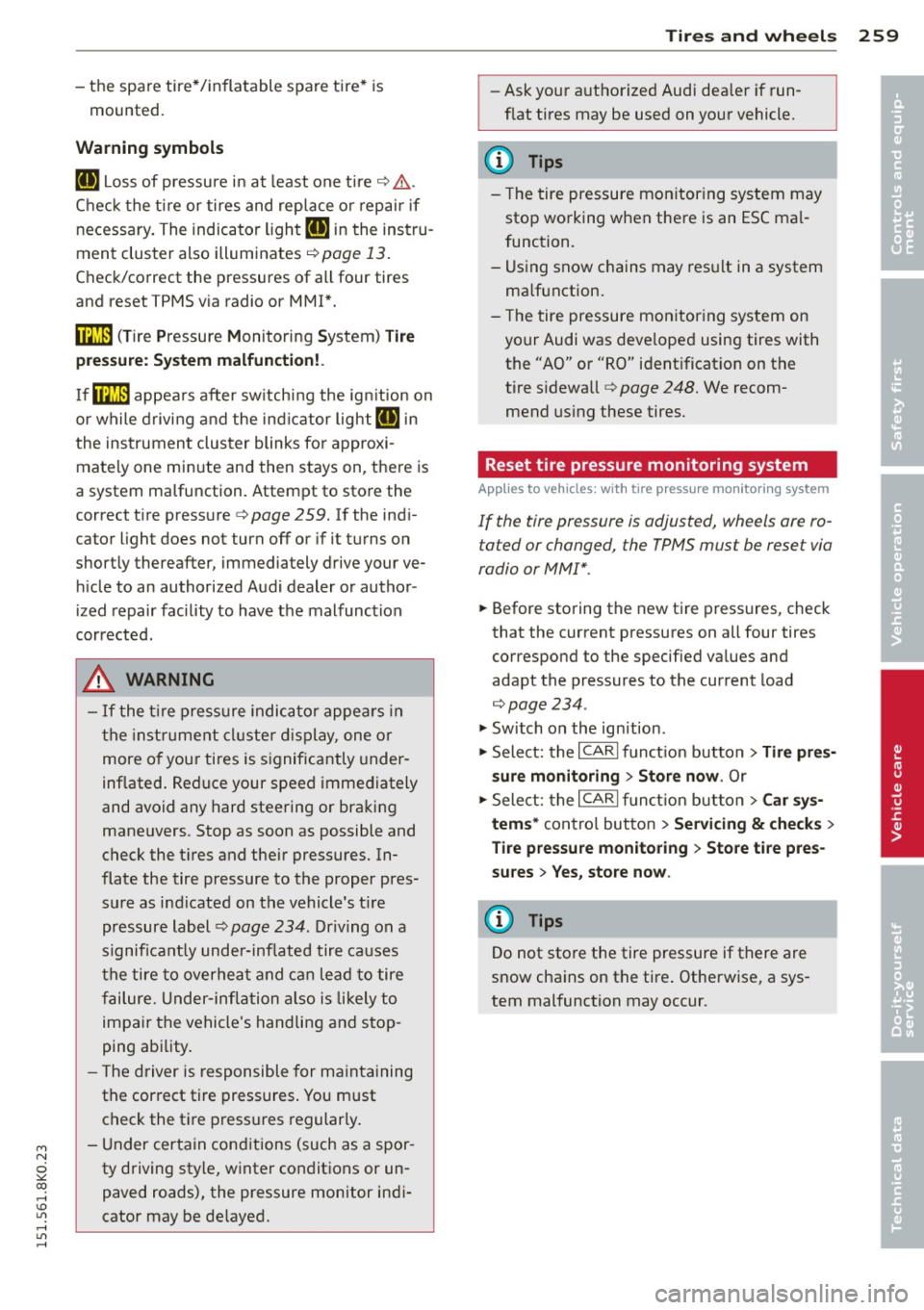
'"" N
0 ::.,: co ,...., \!) ..,.,
,...., ..,., ,....,
-the spa re tire* /inflatable spare tire* is
mounted.
Warning symbols
[IJ Loss of pressure in at least one tireĀ¢,&. .
Check the tire or tires and replace or repair if necessa ry. The indicator light
[IJ in the instru Ā
ment cluster also illuminates
Ā¢page 13.
Check/correct the pressures of all four tires
and resetTPMS via radio or MMI*.
mm (T ire Pressure Monitoring System) Ti re
pre ssure: S ystem m alfuncti on!.
1tE appea rs after sw itching the ign it ion on
or while d rivi ng and the ind icator light
[IJ in
the instrument cluster blinks for approxiĀ mately one minute and then stays on, there is
a system malfunction. Attempt to store the
correct t ire pressure Ā¢
page 259. If the indiĀ
cator light does not turn off or if it turns on
shortly thereafter, immediately drive your veĀ
h icle to an authorized Audi dealer or authorĀ
ized repair facility to have the malfunction
corrected.
.&, WARNING
- If the t ire pressure indicator appears in
the instrument cl uster d isplay, one or
more o f your tires is significantly underĀ
inflated. Reduce your speed immediately
and avoid any hard steering or braking
maneuvers. Stop as soon as possible and
check the t ires and the ir pressures. InĀ
flate the tire pressure to the proper presĀ
sure as indicated on the vehicle 's t ire
pressure label~
page 234 . Driving on a
significantly under-inflated tire ca uses
the tire to overhea t and can lead to tire
failure. Under-inflation also is likely to impair the vehicle 's handling and stop Ā
ping ability.
- The driver is responsible for mainta ining
the correct tire pressures. You must check the tire pressures regularly .
- Under certain cond itions (such as a spor Ā
ty driving style, winter conditions or unĀ paved roads), the pressure monitor indiĀ
cator may be de layed .
Tire s an d wheel s 259
-Ask your a uthorized Audi dea ler if runĀ
flat tires may be used on your vehicle.
(D Tips
- The tire pressure mon itoring system may
stop working when there is an ESC ma lĀ
function.
- Using snow chains may res ult in a system
ma lfunction.
- The tire pressure mon itor ing system on
your Audi was deve loped using tires with
the "AO" or "RO" identification on the
tire s idewall
~ page 248. We recomĀ
mend us ing these tires.
Reset tire pressure monitoring system
App lies to vehicles: with tire pressure mon itor ing system
If the tire pressure is adjusted, wheels ore roĀ
tated or changed, the TPMS must be reset via
radio or MMI*.
... Before storing the new tire pressures, check
that the current pressures on all four tires
correspond to the specified va lues and
adapt the pressures to the current load
Ā¢ page 234.
.,. Switch on the ignition.
.,. Select: the
I CARI funct io n button > Tir e pre sĀ
s ure mon itoring
> Store now . Or
.,. Select: the
I CARI fu nct ion button > Car sy sĀ
tem s*
contro l button > S erv icing & che cks >
Tire pres sure mon itor in g > Store tire pre sĀ
s ures
> Yes, sto re now .
(D Tips
Do not store the tire pressure if there are
snow chains on the tire . Otherwise, a sysĀ
tem mal function may occur.
ā¢
ā¢